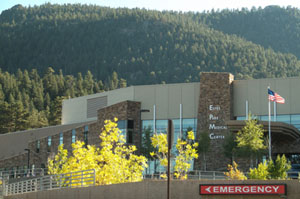As snow begins falling in Rocky Mountain National Park, Estes Park, the town at its doorstep, finds itself newly isolated. The only year-round road into or out of town now is the Peak to Peak Highway. It traverses a jumble of mountains all the way – not the kind of road an ambulance can scream along at 60 miles an hour.
“Not while I’m in the back, hopefully,” jokes ambulance driver and paramedic Erle Collum.
The recent flooding in Colorado washed out the other two roads into town for miles at a stretch.
This is bad news for the town’s hospital. Big city medical facilities that used to be an hour away are now three or four, via this single remaining road connecting the town to the rest of the world.
Collom says he’s grateful the town’s ambulances have four-wheel drive.
“In the winter time we can get some pretty good snow around here, so it’s a nice thing to have, just because of the area we work in,” he says.
It’s typical that there’s snow on the ground from October through May. Estes Park is a town of about 12,000, and it sees 3 million national park visitors a year, but the 25-bed hospital isn’t set up to take care of critical cases for very long. Collom says at least one patient a day gets sent down the mountain to an urban hospital for more advanced care. And not everyone stable enough for the old hour-long ambulance ride will be able to withstand four hours or more on roads Collom calls “not good.”
“They’re not the best roads anyway,” he cautions, “so I suspect it’ll complicate things when winter finally comes around.”
The hospital already makes pretty frequent use of helicopters for the trip to larger hospitals. There’s no place for airplanes to land, and mountain weather keeps helicopters grounded about half the time in winter, says Bill Collins, a paramedic who flies helicopter missions into Estes Park.
“You’re basically kind of like being in the center courtyard of a castle, and the castle walls are the mountains,” Collins says.
Before, the hospital could usually count on either an ambulance or a helicopter as the failsafe. But now, a blizzard that makes air travel dangerous and closes the remaining road could cut off the town.
Damage to the one remaining road to the Estes Park Medical Center could cut the hospital, and town, off from other communities (Photo by Eric Whitney/Colorado Public Radio).
Dr. Martin Koschnitzke, an obstetrician and the hospital’s medical director, worries about possible life and death situations, like a premature birth. Premature babies need an intensive care unit, and there is none in Estes Park.
That means doctors have to hand-pump air into the baby’s lungs constantly until it can get to an ICU with a special ventilator.
“I don’t know how long our pediatricians could manage that baby here,” he said. “I’ve seen them do it for multiple hours. I’d never want to see them do that for multiple days.”
Koschnitzke says there’s nothing worse than not being able to get a patient to needed care.
With an uncertain winter coming, Estes Park hospital interim CEO Bobbi Swenson has to figure out a budget. She expects increased costs and is unsure whether they’ll all get covered. Like whether insurance will pay for a lot more helicopter and ambulance rides.
And then there’s staffing. Half the hospital’s workforce lives down the mountain. Swenson offers them temporary housing during bad weather but, she says, “There are some people that are not going to be willing to come up here for three to four days and be away from their families.”
It’s unclear when daily commuting on the other roads will be feasible again. And the hospital may even be busier, serving townspeople who used to drive down the mountain for everything from orthopedic surgery to chemotherapy and basic primary care.
Many small, rural hospitals like Estes Park’s get special critical access payments from the federal government. But President Barack Obama says he wants to trim those payments by one percent. Swenson says full funding is essential to keep facilities like hers open.
All the uncertainty at the top for now doesn’t change things at the ambulance level in Estes Park. Erle Collom closes his up and gets ready for the next call.
“We’re hanging in there and we’ll get through this flood stuff, and we’re still taking care of people,” he says. “That’s what we do. A little more challenging to get through, but we can do it.”
Engineers say they may restore more access to Estes Park by December, but that may be only a one lane gravel road in many places. State and federal governments have pledged $120 million to fix Colorado’s roads. State officials say repairs may actually cost more than half a billion.
This piece is part of a reporting partnership between NPR and Kaiser Health News.
